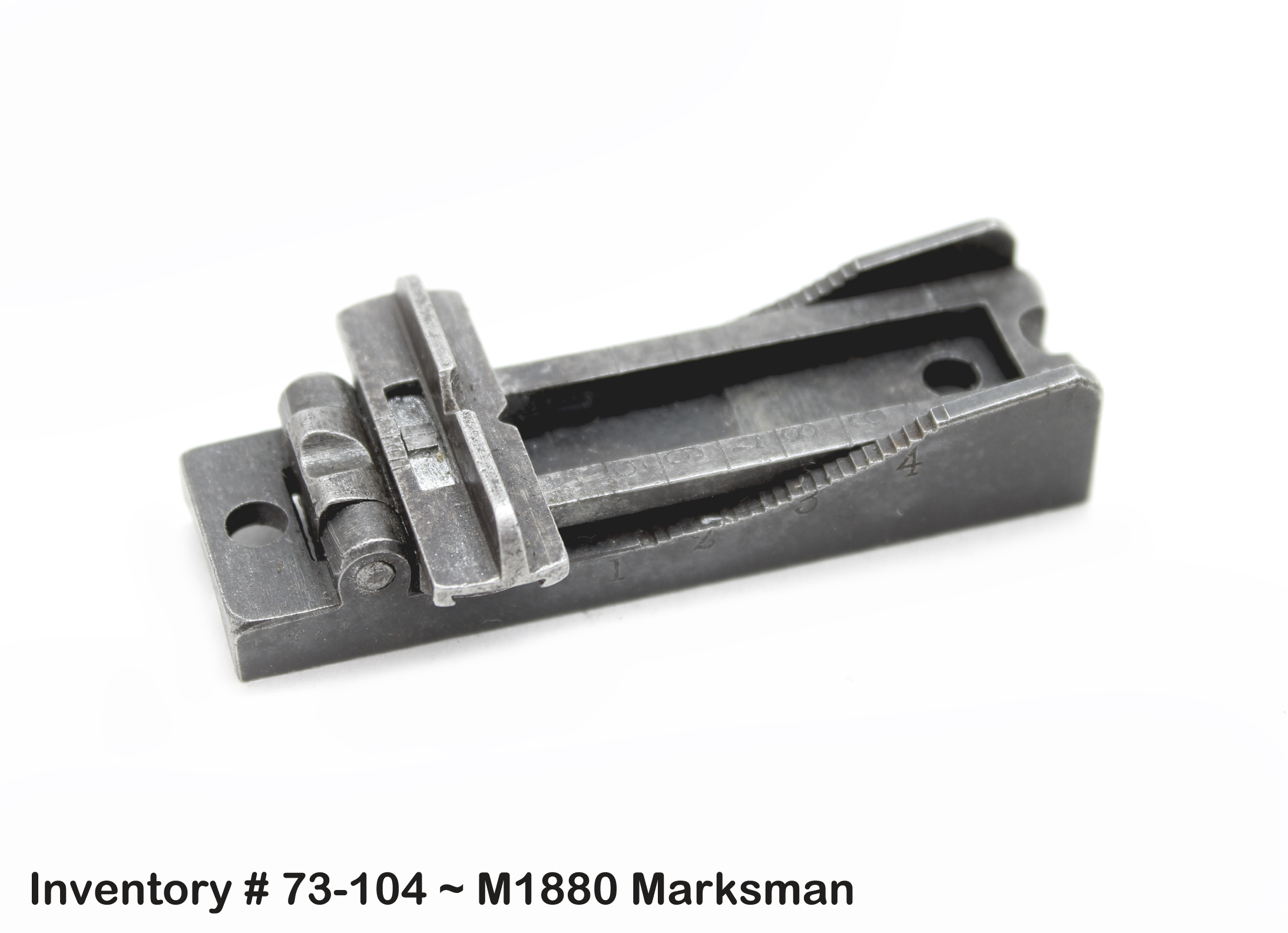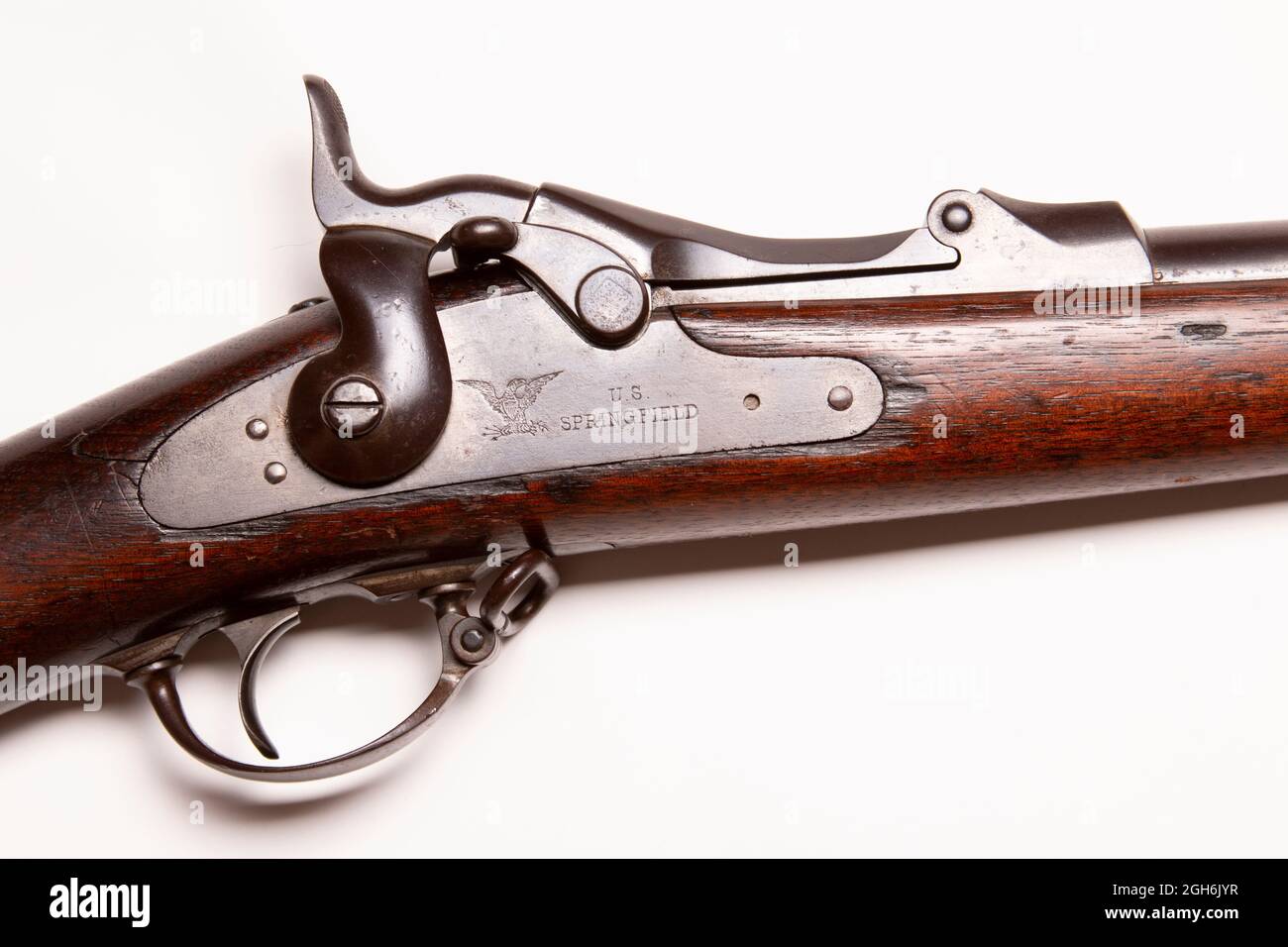


The ramrod is correct with its uncupped head. The stock has a good firing proof and light but very visible script ESA cartouche. There are no cracks or chips except for a couple of very minor chips at the lower ramrod channel.

The stock is very good with the correct long wrist and scattered issue dents and dings. The buttplate is brown with US on the tang. The lockplate is correctly marked US/SPRINGFIELD/1873 with the eagle stamped to the left of that. The lockplate and hammer retain most of their original blue. The high arch breechblock is marked MODEL/1873 /eagle stamp/crossed arrows/US. It is equipped with the correct Model 1873 rear sight with headless attaching screws. The barrel and receiver have a smooth brown patina. The 32 5/8" round barrel has good, bright rifling with some wear and erosion. This Model 1884 Trapdoor Carbine is not the prettiest girl at the dance, but it is not a cut down rifle and still shows as a great example of an important rifle.ĬA Legal or CA Private Party Transferable: This antique rifle can be transferred/sold in California. George Custer’s troops were armed with them at the Battle of the Little Bighorn, and they were still used by secondary units during the Spanish-American war in 1898. Military until they were gradually replaced by the Springfield Model 1892 bolt-action rifle. Our Assessment: The Model 1873 “Trapdoor” Springfield was the first standard-issue breech-loading rifle adopted by the United States Army and it and the Model 18 Trapdoors were the main service rifles of the U.S. As with all used firearms, a thorough cleaning may be necessary to meet your maintenance standards. The hammer has quarter and half cock safety positions. Mechanics: The action functions correctly. Overall, this rifle rates in about Excellent condition. The upper tang screw and the hammer screw are disfigured. The lack of markings on the lock plate is puzzling, possibly removed during a heavy cleaning or rebuild? The hammer knurling shows light wear and is still sharp to the touch. The trapdoor has been reblued and retains about 80% of this newer finish. The left side of the frame has spots of erosion. The barrel and bands appear original finish that has turned brown, with scattered erosion and an often thick patina. Overall Condition: This rifle retains about 20% of its metal finish. There is mild erosion in the bore but a good cleaning will definitely improve this to better than average. Also there is a letter 'A' on the lower right side of barrel in front of breech. When made Markings of lower left Barrel in front of Breech V, P, what appears to be a feather, then another P.
1873 springfield trapdoor barrel band spring serial#
The stock rates in about Good condition.īore Condition: The bore is gray with sharp rifling. I am looking for any information about my Springfield Trapdoor Model 1884 Serial 80835. The buttplate is in about Good condition. The buttplate shows mild erosion and a dark patina.

The comb is 10 ½” in length and the LOP measures 13 1/2” from the front of the trigger to the back of the buttplate. There are no cracks but the wood to metal fit at the buttplate is fair at best. There are several dings, bruises, and drag lines scattered over the surfaces. There are no sling swivels and the carbine is missing the saddle ring. The stock has likely been sanded some time ago, but this is not obvious. The finish is an old oil finish, with some darkening at the metal. The forend does not have a hole for a cleaning rod. The buttstock has a blue steel carbine style buttplate. Stock Configuration & Condition: The stock is a one-piece walnut with a smooth straight grip. There are four different sights for use when the ladder is raised: there is a small peep sight at the bottom of the slider for use as a battle sight, a “U” notch in the base of a triangle for use from 200-1400 yards, a peep near the top of the slider for use at 1400 yards, and a “U” notch at the very top of the slider for use from 1500-2000. The left side of the ladder is marked “15-20” with a hash line every 50 yards. The top right corner of the ladder is marked “R”. The right side of the ladder is marked from “2-14”, with a hash line every 25 yards. The base of the sight is adjustable for windage. There is a “U” notch sight fixed to the rear of the ladder for use as a battle sight when the ladder is folded down. The rear sight is a Buffington ladder sight that was used on the M1884 rifles. Sights / Optics: The front sight is a short blade pinned to a rectangular base on the barrel. The left side of the barrel band is marked “U”.īarrel Length: The barrel is 22” in length. The top of the buttplate in front of the mounting screw is marked “U S”. The top rear of the receiver is marked “132116”. The top rear of the barrel is marked “V”, “P”. Markings: The top of the breechblock is marked “U S / MODEL / 1884”. Arrow_back Returns To All Sold Items arrow_back Return To Sold Pre-1900 U.S.


 0 kommentar(er)
0 kommentar(er)
